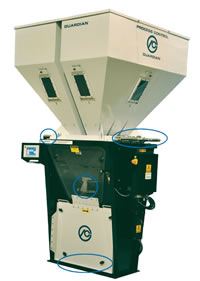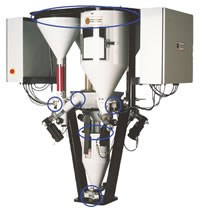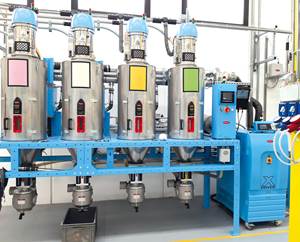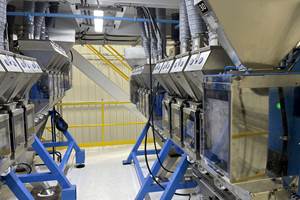Tune Up Your Gravimetric Blenders
Gravimetric blenders provide for the most consistent and accurate blends of plastic materials and additives, but even these seemingly simple machines need some TLC after a long production run.
Gravimetric blenders provide for the most consistent and accurate blends of plastic materials and additives, but even these seemingly simple machines need some TLC after a long production run. Gravimetric systems, with complicated software and sensitive measuring systems, need regular visual inspections, system upgrades, and operator training to ensure maximum performance. At installation, great care is usually taken to ensure proper blender mounting, support, and electrical grounding; but over time these conditions can deteriorate and must be verified. By maintaining a close connection with your machinery provider and understanding the needs of the mechanical and electronic systems, your gravimetric blender will produce outstanding results every time.
BLENDER CONTROL PARAMETERS
Operational parameters should be tuned to the requirements of the process. They should be configured to blend accurately enough for the product produced, but not so tight as to cause excessive alarms and production interruptions. A good starting point, if you are unsure of the correct blender setup, is to compare current parameters with the original machine setup or factory defaults to make sure changes have not been made that could negatively affect performance. Most systems offer various security levels with passwords to limit access to the most critical control parameters. This minimizes the chance that inexperienced personnel could enter incorrect setup values.
With batch weigh blenders, tight dispensing tolerances can cause longer batch times, which will reduce the total output rate. A batch blender setup includes other parameters that could cause intermittent interruption of material feed to the process if not set properly (especially if the blender is mounted on the extruder or molding machine). Programming the blender alarm conditions can be complicated, and setup can vary greatly depending on the process requirements. For most blenders, each alarm condition can be designated as critical or non-critical. The point is to avoid false alarms and unnecessary process interruptions, while on the other hand making sure the end product is produced to specification.
LOADING SETUP & DESIGN
For gravimetric blenders, especially continuous designs, material loading can be critical. Inconsistent loading can cause a variety of blending issues, often resulting in line shutdowns and out-of-spec blends. If setup parameters are correct, a momentary loss of material should cause the blender to pause or shut down before a bad blend is made, and an alarm condition will result. Proper sizing, fill times, and loading priority for the material handling system will help make sure the high-demand ingredient hoppers are kept full. An additional volume of material above the blender may be required to keep the supply hoppers full at all times. An audible alarm is normally available for low-material conditions and should allow adequate time for the operator to react before material runs out.
Most continuous blenders require “demand loading” for the high-rate ingredients, which means they are refilled from a surge bin and discharge gate, not directly from a material loader or central vacuum receiver. If a continuous blender element is being refilled too often, then there is not enough time in gravimetric mode and blender performance will suffer. If you are unsure, consult with your blender supplier for the correct loading design and criteria.
FREQUENT MECHANICAL INSPECTIONS
Regular inspections, as part of a preventive maintenance program, are critical to reliable gravimetric blender operations. Most important is to make sure the weighing system is free from mechanical interference and can make accurate weight measurements. Batch blenders typically have a single weigh hopper located inside the blender frame, just above the mixer, therefore providing good protection from interference. A quick visual check, along with routine recalibration using a known weight, should keep the weighing system in good condition. Further inspection of the dispensing gates and other discharge valves should be made to ensure reliable and leak free operation (see Fig. 1).
The process is a bit more complicated for continuous blenders, which have a separate weighing system for each ingredient. Loss-in-weight hoppers and feeders are usually mounted around an open frame and are more susceptible to mechanical interference. The critical areas to check are around the load cell, the support for the loading, and the feeder discharge (Fig. 2). Also, make sure that things like material hoses, compressed-air lines, and electrical cables are not allowed to touch the weighing system, as this could cause intermittent blending issues.
ELIMINATE ELECTRICAL NOISE & STATIC
Static-electricity discharge is one of the most common causes of failure and poor performance for any gravimetric system. Most of the static is generated by the motion and rubbing of the plastic pellets while moving through the loading-system piping at high speeds. The static is retained on the surface of the pellets as they fall through the blender. Grounded metal tubing is best for discharging the static as it’s being created. Plastic tubing with an embedded ground wire would also help, but to a lesser degree. If possible, the conveying lines should be grounded at the material pickup point to help direct the static charge away from the blender.
A well-grounded blender frame and weigh hoppers will help to reduce static before an electric discharge can reach the weighing system. For maximum electrical noise reduction, tie all panel and hopper grounds to a single frame ground that is tied to the nearest good-quality building earth ground. Clean, isolated supply power and proper machine grounding and static-discharge techniques can help to ensure reliable blender operation.
MINIMIZE VIBRATION
The heart of any gravimetric blender is, of course, a precision weighing system. Isolation from abnormal machine and factory vibration is critical for proper blender operation. Most gravimetric blenders are designed with mechanical, electronic, and software isolation and filtering techniques to protect the system from normal machine vibration effects. However, poorly supported mounting frames and mezzanines can cause excessive vibration that even the best blender design cannot completely overcome. A poorly supported loading system can cause intermittent blender vibrations during refill that can be difficult to diagnose, causing occasional problems with the blend. These types of “every-once-in-a-while” upsets can be the most difficult to troubleshoot.
SOFTWARE & CONTROL UPGRADES
Work with the blender OEM to keep the control software up to date. Blender programming is constantly being developed and enhanced, and most suppliers offer upgrades for a minimal cost. New control electronics can also be available for upgrade, but at a higher cost in most cases. Plants with multiple systems from the same supplier can end up with blenders designed and installed over several years with different electronics and software versions. Not only is having the latest control technology a processing benefit, but keeping all the blenders in the facility running on the same software and hardware revisions can help with training, troubleshooting, standardizing operating procedures, and spare parts inventories.
FORMAL OPERATOR TRAINING
Even the simplest gravimetric blenders have complicated mechanics, a precision weighing system, and a microprocessor controller. A yearly visit from your machinery supplier for a system tune-up and operator refresher course is vital for keeping gravimetric systems running at peak performance. Work closely with your equipment supplier to develop a training program that suits your needs, and consider training classes at the supplier’s demonstration facility for more in-depth machinery and personnel interaction.
About the Author
Dana Darley is technical manager for Process Control Corp., Atlanta. Previously, he was founder and president of Extrusion Auxiliary Services, a consulting and technical services company. He may be reached at (770) 449-8810 or at process-control.com.
Related Content
Finding Efficiencies in How Components Work Together
Auxiliary systems are vital to the proper functioning of a plastic processing line, and they can be a source of major cost and efficiency improvements.
Read MoreCost-Effective Single-Screw Feeder
New line of feeders said to be ideal for pellets, granules, and other free-flowing bulk materials.
Read MoreNovel System Produces Color on Demand
Ampacet’s FluxQF technology features a quick-dispersion universal carrier with novel machinery that provides automated color blending in quantities down to 50 lb.
Read MoreHow to Effectively Reduce Costs with Smart Auxiliaries Technology
As drying, blending and conveying technologies grow more sophisticated, they offer processors great opportunities to reduce cost through better energy efficiency, smaller equipment footprints, reduced scrap and quicker changeovers. Increased throughput and better utilization of primary processing equipment and manpower are the results.
Read MoreRead Next
Troubleshooting Screw and Barrel Wear in Extrusion
Extruder screws and barrels will wear over time. If you are seeing a reduction in specific rate and higher discharge temperatures, wear is the likely culprit.
Read MoreLead the Conversation, Change the Conversation
Coverage of single-use plastics can be both misleading and demoralizing. Here are 10 tips for changing the perception of the plastics industry at your company and in your community.
Read MoreProcessor Turns to AI to Help Keep Machines Humming
At captive processor McConkey, a new generation of artificial intelligence models, highlighted by ChatGPT, is helping it wade through the shortage of skilled labor and keep its production lines churning out good parts.
Read More (2).jpg;maxWidth=970;quality=90)








 (2).jpg;maxWidth=300;quality=90)







 (1).jpg;maxWidth=970;quality=90)